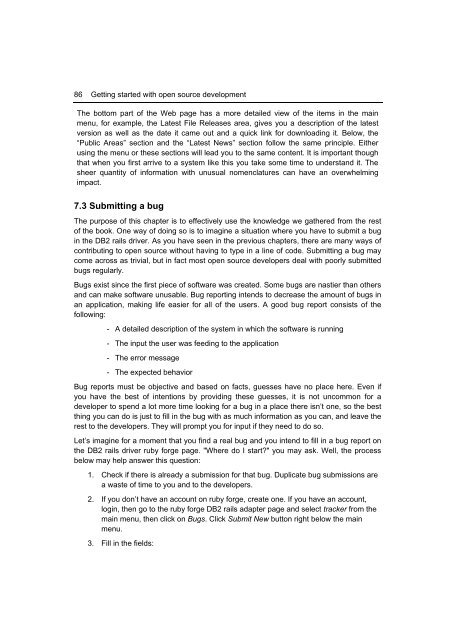Getting Started with Open Source Development
Create successful ePaper yourself
Turn your PDF publications into a flip-book with our unique Google optimized e-Paper software.
86 <strong>Getting</strong> started <strong>with</strong> open source development<br />
The bottom part of the Web page has a more detailed view of the items in the main<br />
menu, for example, the Latest File Releases area, gives you a description of the latest<br />
version as well as the date it came out and a quick link for downloading it. Below, the<br />
“Public Areas” section and the “Latest News” section follow the same principle. Either<br />
using the menu or these sections will lead you to the same content. It is important though<br />
that when you first arrive to a system like this you take some time to understand it. The<br />
sheer quantity of information <strong>with</strong> unusual nomenclatures can have an overwhelming<br />
impact.<br />
7.3 Submitting a bug<br />
The purpose of this chapter is to effectively use the knowledge we gathered from the rest<br />
of the book. One way of doing so is to imagine a situation where you have to submit a bug<br />
in the DB2 rails driver. As you have seen in the previous chapters, there are many ways of<br />
contributing to open source <strong>with</strong>out having to type in a line of code. Submitting a bug may<br />
come across as trivial, but in fact most open source developers deal <strong>with</strong> poorly submitted<br />
bugs regularly.<br />
Bugs exist since the first piece of software was created. Some bugs are nastier than others<br />
and can make software unusable. Bug reporting intends to decrease the amount of bugs in<br />
an application, making life easier for all of the users. A good bug report consists of the<br />
following:<br />
- A detailed description of the system in which the software is running<br />
- The input the user was feeding to the application<br />
- The error message<br />
- The expected behavior<br />
Bug reports must be objective and based on facts, guesses have no place here. Even if<br />
you have the best of intentions by providing these guesses, it is not uncommon for a<br />
developer to spend a lot more time looking for a bug in a place there isn’t one, so the best<br />
thing you can do is just to fill in the bug <strong>with</strong> as much information as you can, and leave the<br />
rest to the developers. They will prompt you for input if they need to do so.<br />
Let’s imagine for a moment that you find a real bug and you intend to fill in a bug report on<br />
the DB2 rails driver ruby forge page. "Where do I start?" you may ask. Well, the process<br />
below may help answer this question:<br />
1. Check if there is already a submission for that bug. Duplicate bug submissions are<br />
a waste of time to you and to the developers.<br />
2. If you don’t have an account on ruby forge, create one. If you have an account,<br />
login, then go to the ruby forge DB2 rails adapter page and select tracker from the<br />
main menu, then click on Bugs. Click Submit New button right below the main<br />
menu.<br />
3. Fill in the fields:

















